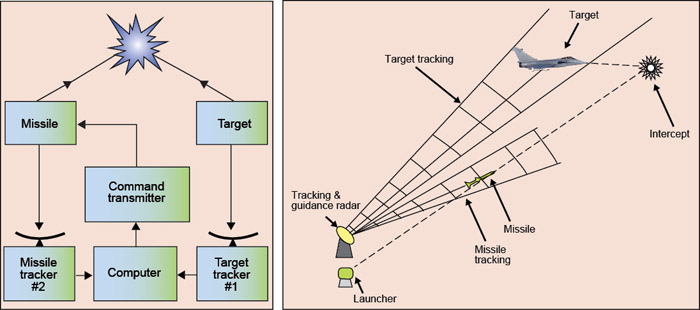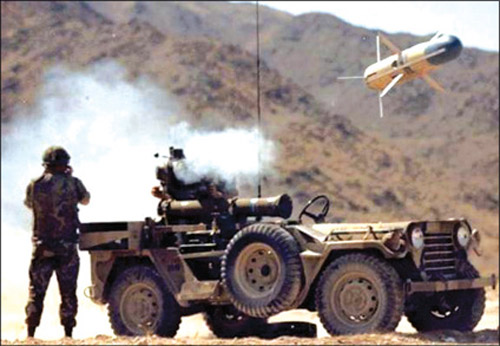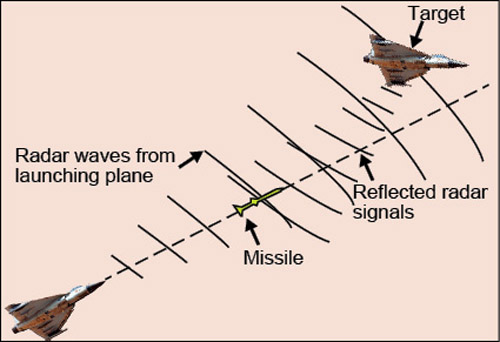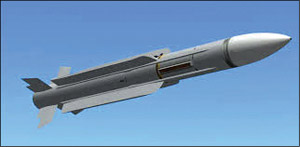Active radar-homing missile has a radar transceiver on board the missile, which finds and continuously tracks the target till it hits it. MBDA MICA short- and medium-range surface-to-air and air-to-air missiles, MBDA EXOCET anti-ship missile of France and DRDO-Astra BVRAAM of India are some examples.
Laser-guided weapons. These weapons make use of a laser beam to guide the weapon (bomb, projectile or missile) to precisely hit the target. Most laser-guided munitions, with the exception of laser beam riding, operate on the principle of semi-active laser homing, similar to semi-active radar homing. A laser beam irradiates the intended target—a process called laser designation. It bounces off the target and gets scattered in all directions. The laser seeker in the munition detects the direction of arrival of laser energy and guides it to the target. Targets employ laser-absorbing paints, smoke screens and active protection systems as countermeasures.
Laser-guided munitions are available as canon-launched surface-to-surface projectiles, aerially-delivered bombs, and surface-to-surface, surface-to-air and air-to-surface missiles. Copperhead and Krasnopol (both canon-launched projectiles), Paveway-II (aerially-delivered bomb) and Hellfire (surface-to-surface and air-to-surface missile) are some examples. Fig. 3 shows Hellfire missile, depicting its inner parts.
Infra-red-guided weapons. Infra-red-guided weapons make use of electromagnetic radiation emitted from the target, predominantly in the infra-red part of the spectrum, to track the target and then home onto it. Such missiles are also referred to as heat-seeking missiles. The seeker head in this case is an infra-red sensor, located on the tip or head of the missile. The infra-red seekers are designed to be sensitive to either 3-5 micron band, in which case these are called single-colour seekers, or 3-5 micron and 8-12 micron bands and referred to as two-colour seekers. Infra-red missiles using two-colour seekers are far more immune to countermeasures like flares.

Another variant of the infra-red-guided missile is the one employing an imaging infra-red (IIR) seeker head, which uses IR/UV focal plane sensor array. Missiles employing IIR seeker heads are far more resistant to countermeasures and are less likely to be fooled into locking onto the Sun’s radiation.
IRIS-T manufactured by Diehl BGT Defence as part of Germany-led multinational program is an advanced air-to-air guided missile employing IIR seeker. It has three variants including IRIS-T (air-to-air guided missile), IRIS-TSL (surface-launched medium-range-guided missile) and IRIS-T (surface-launched short-range-guided missile).
Wire-guided weapons. In this case, the missile is guided by electrical signals sent to it through a bundle of wires connected between the missile and the guidance mechanism located near the launch site. The wires reel out behind the weapon as it flies. Wire guidance is commonly used in anti-tank missiles, where its suitability in limited line-of-sight availability is particularly advantageous. Also, the missile’s limited range, imposed by length of the wire, is not an issue in anti-tank operations. Tube-launched optically-tracked and wire-guided (TOW) of the USA with an operational range of 3750 metres and MILAN of France (Fig. 4) with an extended operational range of 3000 metres (MILAN ER) are well-known in-service wire-guided missiles.
TOW family of missiles, including TOW 2A, TOW 2B Aero and TOW Bunker Buster missiles, is the premier long-range, heavy-assault-precision anti-armour, anti-fortification and anti-amphibious-landing weapon system. TOW missiles have been integrated on ground, vehicular and helicopter platforms. MILAN is a portable medium-range anti-tank missile, with later versions equipped with tandem heat warheads, making it more effective against reactive armour.
Beam-riding weapons. Beam-riding weapons make use of a radar or laser beam for guidance. A narrow radar or laser beam is directed at the target, usually a tank or an aircraft. The missile is launched in the direction of the target and sometimes, after it is launched, it flies into the radar or laser beam. With the help of sensors and a computer onboard the missile, it keeps itself within the beam. The aiming station keeps the beam pointed at the target till it hits it. The inherent shortcoming of the radar-beam-riding guidance is that the beam spreads as it moves away from the aiming station. Laser beam riders do not have this limitation.



Beam-riding guidance is generally used for short-range air-defence and anti-tank-guided missile applications. LAHAT (short-range anti-tank missile manufactured by Israel Aerospace Industries) (Fig. 5), Starstreak (short-range air-defence system manufactured by Thales Air Defence) and RBS-70 (short-range anti-tank guided missile manufactured by SAAB Bofors Dynamics) are known laser beam riders.







Top stories
Thank you for your feedback.